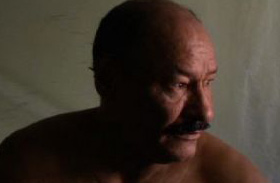Spawned from a 2005 headline that director Alejandro Landes saw in the paper, Porfirio is a very strong arthouse project from South America that transfers the daily life of a man – who hijacked a plane by hiding grenades in his diapers – into a contemplative and formally precise recreation of the genesis of this conflict. The film is just as much Porfirio’s as it is Landes’, as the wheelchair-bound hijacker not only plays himself in the film, but was also largely involved in the collaborative penning stages. Detailing the injustices of the physically disabled in Colombia, the impact may be short on pathos, but it makes up for it with a rigid formality that frames its themes of immobility, claustrophobia, and personal redemption.
For much of the first half, we follow Porfirio, appearing in nearly every scene of the film, through his daily routines, aided by his son, Lissin. Left paralyzed from a cop’s bullet to the spine, he must partake in awkwardly cumbersome strategies in order to accomplish any bodily function, from bowel movements to sex. To worsen matters, his wheelchair is worn down and on the verge of ripping into pieces, and he doesn’t exactly have the funds for a new one. Held in the confines of his dingy home, his limited means of transporting through his own cramped living space is exhausting to behold, let alone witnessing the trials awaiting him in exterior environments.
All of this is handled with very matter-of-fact lensing. The CinemaScope widescreen frame is expansive well beyond the delineated spaces Porfirio occupies. His placement in the frame is always central, forming symmetrical compositions that place equal negative space on both sides of him; there is a sense that he is blocked into this small region of an otherwise expansive zone. When the camera does on the rare occasion move, it is to track Porfirio as he wheels along, mimicking his rolling motion via the camera’s own wheeling glide, still insistent on lodging him in the center.
The film is ultra-naturalistic, likely due to the method of producing the script. Landes and Porfirio went back and forth writing and rewriting the dialogue, until they’d concluded that all of the dialogue was what Porfirio would actually say in life. This manner of writing chloroforms any of Landes’ own stylization out of the final product, molding it into what is essentially a staged documentary. As the film progresses, it becomes ambivalently more elliptical and plot-driven. Deviating away from its slice-of-life formula into one of impending violence, the last scenes will be most-rewarding for those completely unfamiliar with Porfirio’s claim to fame.
Layered and haunting, Landes’ first non-documentary feature shows tons of promise. It surfaces at a time when fiction/documentary hybrids are making a lot of noise on the festival circuits (they seem especially popular in South America, such as Alamar and Paraguayan Hammock, to name a couple). Porifiro isn’t necessarily a giant leap forward in the format, but it is a solid entry, and will be frequently revisited if/when Landes’ next few films gain him some notoriety.
2011 Cannes Int. Film Festival – Directors’ Fortnight
Reviewed on May 15th
